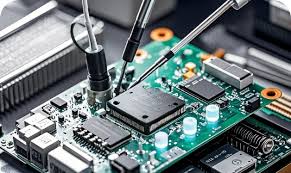Introduction
In the realm of electrical systems, switchboards and panelboards play crucial roles. While they may seem similar, their functions, designs, and applications are distinct. This article delves into these differences, offering insights into how each component fits into the broader electrical infrastructure.
Historical Development
Evolution of Switchboards
Switchboards have been integral to electrical systems since the early days of electricity distribution. Initially simple structures, they have evolved into complex units capable of handling high power loads.
Development of Panelboards
Panelboards, on the other hand, emerged as a solution for smaller-scale electrical distribution needs. They have become a staple in residential and commercial buildings, adapting to the changing power distribution demands.
Technological Advancements
Both switchboards and panelboards have benefited from technological advancements, including improved safety features and integration with digital monitoring systems.
Design and Construction Differences
Physical Structure and Components
- Switchboard Structure: Typically larger, switchboards are designed to handle higher capacities with multiple panels and protection devices.
- Panelboard Structure: More compact, panelboards are designed for localized distribution with a simpler layout.
Material and Manufacturing Variations
Switchboards often use more robust materials due to their high-power handling, whereas panelboards are constructed with lighter materials.
Safety Features
Both adhere to stringent safety standards, but switchboards often incorporate more advanced safety mechanisms due to their higher power handling.
Functional Differences
Electrical Capacity and Load Management
- Switchboard Capabilities: Designed for higher capacity, switchboards can manage extensive electrical loads, suitable for industrial settings.
- Panelboard Limitations: More suited for lower capacity needs, panelboards are common in residential and small commercial buildings.
Control Mechanisms
Switchboards often feature more complex control mechanisms, reflecting their use in environments requiring detailed electrical management.
Applications and Use-Cases
Typical Use-Cases for Switchboards
- Industrial and Large Commercial Settings: Here, switchboards manage high power loads and integrate with other electrical systems.
- Advanced Control Systems: They often interface with sophisticated control systems for comprehensive electrical management.
Common Applications for Panelboards
- Residential and Small Commercial Buildings: Panelboards are ideal here for their simplicity and ease of use.
- General Use: Their straightforward design makes them accessible for general applications.
Installation and Maintenance Considerations
Space Requirements
Switchboards require more space due to their size and complexity, whereas panelboards are more compact.
Maintenance Needs
Switchboards typically demand more rigorous maintenance routines, given their complexity and the high stakes of industrial machinery settings.
Safety Precautions
Both require adherence to safety standards, but switchboards may necessitate more stringent safety protocols.
Cost Comparison and Economic Factors
Initial Investment
Switchboards are generally more expensive due to their larger size and complexity.
Operational Costs
The long-term operational costs can vary, but switchboards might incur higher costs due to their extensive maintenance needs.
Future Trends and Innovations
Smart Technology
The integration of smart technologies is set to enhance the functionality and efficiency of switchboards and panelboards.
Sustainability
Advancements in energy efficiency are crucial, with both systems evolving to meet sustainable energy demands.
Future Design Shifts
Emerging technologies may further differentiate switchboards and panelboards, or possibly blur the lines between them.
Conclusion
Switchboards and panelboards, while serving the common purpose of electrical distribution, are tailored for distinctly different environments and needs. Understanding these differences is key for professionals in making informed decisions about electrical system design and implementation.
References
Further reading and detailed technical specifications, industry standards, academic publications, and expert opinions provide information on these critical components of modern electrical systems.
The landscape of electrical distribution is continually evolving, and staying informed is crucial for professionals in the field. Here are some recommended sources for further exploration and deeper understanding:
Industry Standards and Guidelines
- National Electrical Code (NEC): Provides comprehensive guidelines on the installation and management of electrical systems, including switchboards and panelboards.
- Institute of Electrical and Electronics Engineers (IEEE): Offers detailed papers and standards that delve into the technical aspects of electrical distribution systems.
Academic and Technical Publications
- Electrical Engineering Journals: Publications like the IEEE Transactions on Industry Applications provide peer-reviewed articles on the latest developments in switchboard and panelboard technology.
- Technical Books: Books focusing on electrical power systems offer in-depth discussions on the design, operation, and maintenance of switchboards and panelboards.
Interviews and Expert Opinions
- Industry Conferences: Events like the IEEE Power and Energy Society General Meeting often feature panels and discussions by experts in the field.
- Online Forums and Webinars: Platforms like IEEE Xplore and industry-specific webinars can be valuable resources for current trends and expert insights.
Final Thoughts
Choosing between a switchboard and a panelboard is not just a matter of preference but a decision that hinges on specific needs, capacities, and environments. As our world becomes increasingly powered by complex and demanding electrical systems, the roles of switchboards and panelboards are more critical than ever. With ongoing advancements in technology and a growing focus on sustainability and efficiency, the future of these systems is poised for exciting developments.
In conclusion, whether it’s a high-capacity industrial setting requiring the robustness of a switchboard or a residential building needing the simplicity of a panelboard, understanding the nuances of each system is essential. This knowledge ensures not only the efficient and safe distribution of electricity but also paves the way for innovations that could redefine power management in the years to come.





























